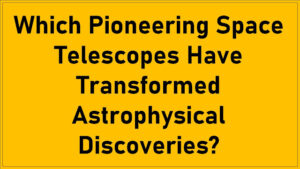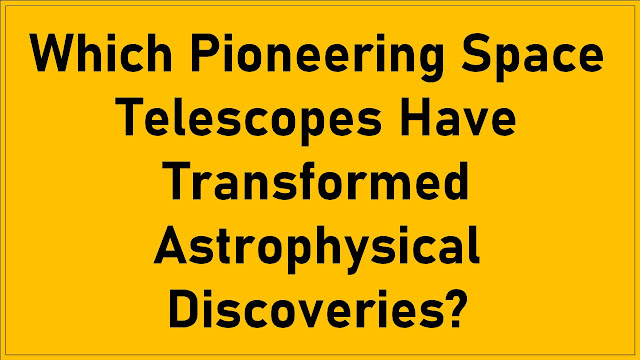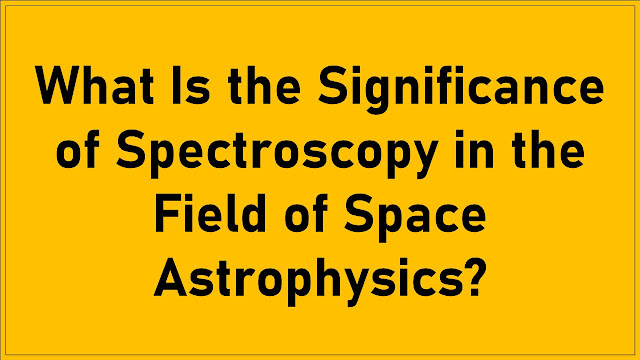
Introduction.
In this article, I’ll embark on a cosmic journey to explore the remarkable contributions of pioneering space telescopes that have redefined our understanding of the universe and reshaped the landscape of astrophysical discoveries. Over the past several decades, these sophisticated instruments have transcended the confines of Earth’s atmosphere, offering astronomers an unobstructed view of the cosmos. Through their intricate design, precise observations, and groundbreaking findings, these space telescopes have not only expanded our knowledge but have also ignited our collective fascination with the mysteries of the universe.
As we delve into the narratives of these extraordinary observatories, we will uncover how they have unveiled hidden celestial phenomena, elucidated the nature of dark matter and dark energy, and deepened our comprehension of distant galaxies and exoplanets. Their transformative impact on astrophysics has not only revolutionized our understanding of the cosmos but has also paved the way for future generations of space-based observatories, promising even more profound revelations about the universe we call home.
- Hubble Space Telescope: Revolutionized astronomy with stunning deep-space images.
- Chandra X-ray Observatory: Unveiled high-energy phenomena in the universe.
- Spitzer Space Telescope: Explored the universe in the infrared spectrum.
- Kepler Space Telescope: Discovered thousands of exoplanets, redefining planetary science.
- James Webb Space Telescope: Upcoming, promises to explore distant galaxies.
- Fermi Gamma-ray Space Telescope: Studied gamma-ray sources in the cosmos.
Hubble Space Telescope: Revolutionized astronomy with stunning deep-space images.
The Hubble Space Telescope, launched in 1990, stands as one of the most iconic and transformative space telescopes in the history of astrophysics. It owes much of its fame to its ability to capture breathtakingly detailed and sharp images of distant celestial objects. Hubble’s position above Earth’s atmosphere eliminates the blurring and distortion caused by atmospheric turbulence, allowing it to provide unprecedented clarity in its observations.
One of Hubble’s most significant contributions has been its role in expanding our understanding of the age and size of the universe. It has measured the rate of the universe’s expansion, known as the Hubble constant, with great precision. Furthermore, Hubble’s deep-field observations have revealed galaxies that existed when the universe was in its infancy, shedding light on the early stages of cosmic evolution.
Additionally, Hubble’s images have provided insights into the birth and death of stars, the existence of supermassive black holes at the centers of galaxies, and the discovery of new moons and planetary rings in our own solar system. In essence, Hubble has transformed our view of the cosmos, and its images have become icons of astronomical discovery.
Chandra X-ray Observatory: Unveiled high-energy phenomena in the universe.
Launched in 1999, the Chandra X-ray Observatory is another pioneering space telescope that has revolutionized astrophysics. Unlike visible light telescopes like Hubble, Chandra is designed to detect X-rays emanating from high-energy sources in the universe, such as black holes, supernova remnants, and clusters of galaxies. By observing X-rays, Chandra provides insights into some of the most energetic and extreme processes in the cosmos.
Chandra has been instrumental in the study of black holes. It has observed X-ray emissions from supermassive black holes at the centers of galaxies, revealing their activity and influence on their surroundings. The telescope has also captured X-ray emissions from stellar-mass black holes, shedding light on the violent processes of matter accretion and ejection near these objects.
Additionally, Chandra has uncovered the dynamics of galaxy clusters, offering evidence for the existence of dark matter and revealing the intricate interplay between visible matter, dark matter, and dark energy in the universe. It has also studied the remnants of exploded stars, known as supernova remnants, helping scientists better understand the life cycles of stars and the dispersal of elements throughout space.
Spitzer Space Telescope: Explored the universe in the infrared spectrum.
The Spitzer Space Telescope, operational from 2003 to 2020, focused on exploring the universe in the infrared portion of the electromagnetic spectrum. This capability allowed it to observe objects and phenomena that are typically invisible in visible light, such as cool stars, dusty regions of space, and the early universe.
One of Spitzer’s groundbreaking achievements was its study of exoplanets. It contributed to the detection and characterization of exoplanets by measuring their infrared emissions and studying their atmospheres. Spitzer’s observations played a vital role in identifying molecules like water and methane in the atmospheres of exoplanets, offering clues about their potential habitability.
Additionally, Spitzer provided essential insights into the formation of stars and planetary systems. It observed protoplanetary disks, the birthplaces of planets, and captured images of newborn stars surrounded by dusty cocoons. These observations helped scientists understand the processes involved in planetary formation.
Kepler Space Telescope: Discovered thousands of exoplanets, redefining planetary science.
Launched in 2009, the Kepler Space Telescope revolutionized our understanding of the prevalence of exoplanets, planets orbiting stars outside our solar system. Kepler’s primary mission was to continuously monitor a patch of the Milky Way, observing the brightness of hundreds of thousands of stars simultaneously. This method, known as the transit method, allowed Kepler to detect exoplanets as they passed in front of their host stars, causing temporary drops in brightness.
Kepler’s groundbreaking discoveries include the identification of over 2,600 confirmed exoplanets and thousands of candidates. It revealed that exoplanets are common in the galaxy, ranging from small rocky planets to massive gas giants. Kepler’s data also provided valuable information about the size, orbital characteristics, and habitability potential of these newfound worlds.
One of Kepler’s most significant findings was the concept of the “habitable zone” or “Goldilocks zone,” the region around a star where conditions might be suitable for liquid water to exist on the surface of a planet—an essential factor for potential life. Kepler identified numerous exoplanets within this zone, sparking interest in the search for Earth-like planets and the potential for extraterrestrial life.
James Webb Space Telescope: Upcoming, promises to explore distant galaxies.
The James Webb Space Telescope (JWST) is one of the most highly anticipated space telescopes, set to launch in the near future (as of my last knowledge update in September 2021). It is designed to build upon the legacy of the Hubble Space Telescope and expand our understanding of the universe. JWST will operate primarily in the infrared spectrum and boasts a much larger mirror, enhancing its ability to observe distant galaxies and objects.
JWST’s main scientific goals include studying the formation of stars and planetary systems, investigating the atmospheres of exoplanets, and examining distant galaxies and the early universe. It will provide unprecedented insight into the formation and evolution of galaxies and offer glimpses into the universe’s infancy shortly after the Big Bang.
This space telescope’s advanced capabilities, such as its ability to study the spectra of exoplanets and identify the chemical compositions of their atmospheres, hold great promise for the search for habitable planets and the potential for life beyond Earth. JWST is expected to transform our understanding of astrophysics, just as its predecessors have done.
Fermi Gamma-ray Space Telescope: Studied gamma-ray sources in the cosmos.
Launched in 2008, the Fermi Gamma-ray Space Telescope is a mission dedicated to exploring the high-energy universe through the detection of gamma rays. Gamma rays are the most energetic form of electromagnetic radiation, originating from some of the most extreme and violent cosmic phenomena.
Fermi has made significant contributions to astrophysics by studying gamma-ray sources such as pulsars, gamma-ray bursts, and active galactic nuclei. It has helped scientists understand the nature of these sources, their emission mechanisms, and their role in cosmic evolution. For example, Fermi has revealed insights into the behavior of pulsars, which are rapidly rotating neutron stars, and their emission of gamma-ray pulses.
One of Fermi’s most remarkable discoveries was related to gamma-ray bursts, which are among the most powerful explosions in the universe. It provided valuable data on their frequency, duration, and spectral characteristics, shedding light on the physics behind these enigmatic events.
Conclusion.
I hope this exploration of pioneering space telescopes and their profound impact on astrophysical discoveries has provided a deeper appreciation for the remarkable strides made in our understanding of the universe. Over the decades, these cutting-edge instruments have revolutionized our perception of the cosmos, unveiling hidden wonders and answering longstanding questions about the nature of the universe. From the Hubble Space Telescope’s stunning images that have reshaped our comprehension of galaxies and their evolution to the Chandra X-ray Observatory’s revelations about the high-energy phenomena, these telescopes have been instrumental in advancing our knowledge.
In closing, it is evident that space telescopes like Hubble, Chandra, and Kepler have transformed astrophysical research, allowing us to glimpse into the depths of the universe and unravel its mysteries. As we look forward to the next generation of space observatories, such as the James Webb Space Telescope, we anticipate even more groundbreaking discoveries that will continue to shape our understanding of the cosmos and our place within it. The legacy of these pioneering space telescopes serves as a testament to human curiosity and our relentless pursuit of knowledge about the universe that surrounds us.










